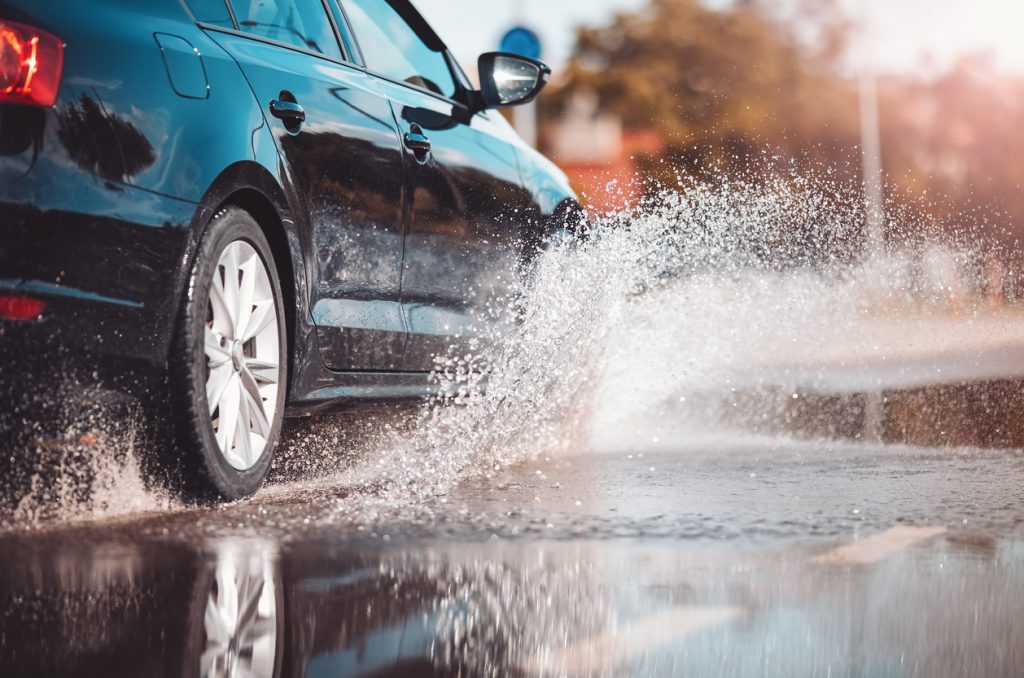Driving in the UK requires you to adapt to a multitude of different adverse weather conditions, but the one that you’ll have to deal with the most is rain. Wet conditions can play havoc with your vehicle, whether that’s by damaging components or forcing you to drive slower and more carefully.
Aquaplaning (or hydroplaning, as it’s also known) falls into the latter category and can be dangerous, if not deadly, for drivers who don’t know how to react when they fall victim to this wet weather incident. Take extra care during the rainier months, because when there’s water on the road surface, any car is susceptible to aquaplaning.
Understanding how to counteract the effects of aquaplaning, or better still, how to prevent it in the first place could be live-saving. Read on to learn how best to battle back against aquaplaning.

What Is Aquaplaning?
To avoid aquaplaning, you need to know exactly what it is, of course. Simply put, aquaplaning occurs when a layer of water collects on the surface of a road and separates your car’s tyres from the tarmac. The car, essentially, begins to glide along the road with no or very little traction, removing all control from the driver. If you’re behind the wheel, you’ll notice that you can’t steer, accelerate or even brake. This can be especially dangerous if it happens in locations where high speed combines with the need for careful manoeuvring, such as motorways or country lanes. By the time your tyres reconnect with the road and you regain control, it might be too late to prevent an accident.
What Causes Aquaplaning?
We’ve established that aquaplaning is caused by surface water, and the deeper it is, the more likely you are to glide, but are there specific actions that cause one car to aquaplane where another one might not? In a word: yes.
- Excessive speed can cause aquaplaning. Think of your car like a stone, and the surface water as a lake. If you throw that stone across the surface at high speed, it’s going to skim along rather than sink, and it’s only going to travel in a straight line. This is kind of like what happens when your car aquaplanes due to high speed.
- Worn-down tyres with less tread definition are more likely to aquaplane because they won’t disrupt the surface of the water as easily, meaning that they’re more susceptible to gliding over the surface.
- Low-profile tyres with a wider tread offer more surface area to distribute the weight of your car across the water’s surface, therefore reducing the chance of the tyre plunging through the water and connecting with the road.
How to Tell If Your Car Is Aquaplaning
If your car begins to aquaplane, you’ll need to react quickly to have any chance of rescuing the situation. Lucky, there are some tell-tale signs that your car has lost traction because of water on the road.
- Listen out for the sound of your engine. If there is a sudden increase in volume, and the revs on your dashboard counter go through the roof, you’re probably aquaplaning.
- Your steering will immediately feel light. The sense that you’ve lost control of the vehicle will be apparent, but it’s important that you don’t panic.
- Your car’s rear-end will be sliding left or right. If you get the sense that you’re drifting either way, your wheels have almost certainly lost contact with the tarmac.
What to Do If Your Car Starts Aquaplaning
Once you’re sure that your car is aquaplaning, you’ll want to implement countermeasures to make sure you and your car come out the other side unscathed.
- Act calmly and in a measured way: Your first instinct will probably be to attempt an emergency stop, but stepping on the brakes could cause your car to spin completely if it is momentarily regaining traction as you glide.
- Keep a firm grip on the steering wheel: But, don’t squeeze it too tight as you may end up making erratic movements. You’re aiming to keep the wheel as straight as possible so that if the car does sporadically touch the road surface, you’re not going to suddenly veer to either side.
- When control returns, brake steadily: Try to avoid hard, sudden braking if space and time allows.
How to Prevent Aquaplaning
Thankfully, there are measures that you can take to stop an aquaplane incident before it even happens.
- Keep an eye on the weather: The weather in the UK can often take a turn for the worst in an instant, with thunderstorms sometimes getting the drop on unexpecting drivers and making their lives more difficult. However, the Met Office are pretty good at what they do, and can give you a fairly accurate prediction of what weather might be on the horizon. If heavy rain is inbound, consider altering your route to use roads that are less liable to hold water on their surface.
- Drive slower, brake softer and take more care: Lower speeds and less harsh braking will prevent aquaplaning, enabling your car to maintain traction on the road more easily.
- Drive more centrally: A lot of roads, particularly country lanes, have a slight hump-like camber which allows water to pool towards the edges. Driving closer to the centre (or the ‘crown’ of the camber) will reduce the amount of water you’ll be driving through.
- Check (and upgrade) your tyres: Make sure you’re regularly checking your tyres tread and pressure. You should already know that there’s a legal limit to how low the tread can be, but just because it’s above that level, it doesn’t mean they’re immune to aquaplaning. Upgrading to better tyres will help keep traction even in wet conditions.
What To Do If You Have An Accident After Aquaplaning
If your car has aquaplaned and is now in a less-than-fit state to be ideal, or if you want to upgrade to something safer, consider selling your car to Scrap Car Comparison. We’ll find you the best price in just 30 seconds and our vast network of trusted expert buyers will collect your car for free, from anywhere in the country. Check out how much you could get for your car, and sell it as scrap or salvage today.

